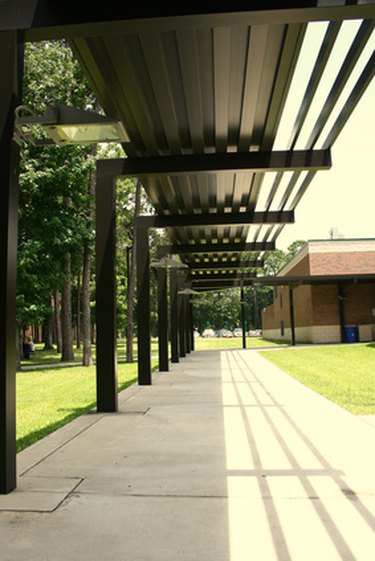
In architectural terms, a soffit is the underside of any overhanging structure. Outdoors, this can be the area under roof overhangs or decks. Indoors, soffit generally refer to a dropped ceiling around the edges of the room but also can mean the area between the top of kitchen cabinets and the ceiling, even if it isn't lowered. Soffit lighting refers to any lighting that is placed in these areas.
Types
Video of the Day
Soffit lighting can be direct or indirect. Direct lighting refers to light that is focused on an area or object, so track lighting installed under an indoor soffit or safety lighting installed under an outdoor soffit are considered direct lighting. Recessed lighting is also a popular form of direct lighting from soffits, because it fits within the soffit but illuminates useful areas.
Video of the Day
Some designers also consider lighting installed underneath cabinets to be soffit lighting. This can be direct if it is used to illuminate the work surfaces of the countertop or indirect if it is low-level ambient lighting that does not serve as sufficient light for countertop work. Other indirect lighting includes units in the space between the cabinet tops and ceiling, whether a subtle ambient glow or bounced off the ceiling to produce general illumination.
Uses
Because of its ability to hide lighting fixtures and produce ambient glows, soffit lighting is often used as interior mood lighting, creating a luxurious, playful or romantic atmosphere, depending on the brightness and color of the light.
Outdoor soffit lighting can be used to enhance architectural features at night or for safety by illuminating dark areas so visitors are less likely to stumble. Motion-activated outdoor soffit lighting can be used as a theft deterrent.
Wiring
To keep wiring from being visible, soffit light wiring on top floors is frequently run through the attic. However, in the case of post-construction soffits that are built purely for lighting design purposes, the wiring is often inside the soffit. Depending on the accessibility of the attic, this may simplify the wiring process and make it cheaper than installing lights with wiring that must be run inside the walls.
Under-cabinet soffit light wiring may be run along the back edge of the cabinets to the power source or a hole may be drilled to allow the wiring to be hidden inside the cabinets. Many companies also offer battery-powered under-cabinet lighting, which reduces installation difficulty.
Creating Soffits
If your home does not have soffits and you would like to install soffit lighting, they may be added in the form of dropped ceiling portions around the outside of the room or "inverted tray" ceilings, which add a dropped panel to the center portion of the ceiling over part or all of a room.
Simple rope lighting can be placed just inside the perimeter around the dropped "tray," creating a glow around the edges of the tray. Small dropped trays in a kitchen area may double as hanging pot racks.
Fun Fact
Soffit lighting is not just for homes and businesses. Lighting above roadways hangs from or is recessed into overpasses or building overhangs is also soffit lighting. However, state regulations restrict the type of soffit lighting instruments that can be used. In California, only high-pressure sodium lamps that are 70 or 100 watts may be used.